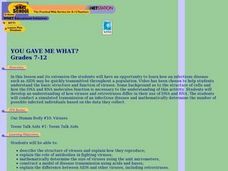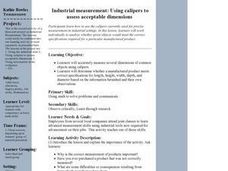Curated OER
Industrial Measurement: Using Micrometers in the Workplace
Students accurately measure several common objects for thickness using micrometer calipers. They work individually to analyze whether given objects would meet the correct specifications required for a particular manufactured product.
Baylor College
Comparing Sizes of Microorganisms
Kids compare what printed text looks like with the naked eye and under magnification. They discuss the extremely small scale that must be used to measure the size. They learn about the micrometer unit, then draw scale models of a variety...
Curated OER
Lesson #2 ~ Nanoscience and Nanotechnology
You might love this lesson, or you might not. Basically, high school scientists read through a script in which someone interviews a physicist, a biologist, and a chemist in regard to their use of nanotechnology. The names of the involved...
Curated OER
Can You Canula?
Students calculate the circumference of a circle. In this geometry instructional activity, students measure the diameter of a circle using micrometers or calipers. They investigate the relationship of the diameter to that of the value of...
Curated OER
Brine Shrimp Feeding
Third graders study the diet of the brine shrimp. This is an introduction to a math measurement of a micrometer because of the size of the food brine shrimp feed upon. They make predictions about the types of food shrimp eat based on...
Cornell University
Fibers, Dyes, and the Environment
Nanofibers can be made through electrospinning or force spinning in order to reduce the negative impact on the environment. Pupils study the role of fibers and dye on the environment through a series of five hands-on activities. Then,...
Curated OER
The Microscope and Cell
In this science worksheet, students calculate the size of different samples using the microscope as part of a formal lab assignment.
Curated OER
Microscopy
In this microscope worksheet, students complete 15 review questions of labeling, defining and short answer after finishing a compound microscope lab. Lab included.
Curated OER
Death by Particles
Emerging epidemiologists define relative risk and read an article about the effect of particulate pollution on the cardiovascular health of women. They record the relative risk values, graph them, and answer analysis questions. This is a...
Curated OER
You Gave Me What?
Students see how an infectious disease such as AIDS may be quickly transmitted throughout a population. They conduct a simulated transmission of an infectious disease and mathematically determine the number of possible infected individuals.
Curated OER
Create a Microbe
Students construct models of microorganisms recognizing size relationships-comparing the size of viruses with the sizes of bacterial and eukaryotic cells. They put into perspective just how small microbes are by comparing the size of...
Curated OER
Cell Discoveries
Young scholars observe, compare and describe cell organelles in terms of their function, structure and operation. They enter and edit information in a database, build and sort a student-designed database and find records in a database.
Curated OER
Industrial Measurement: Using Calipers to Assess Acceptable Dimensions
Students accurately measure several dimensions of common objects using calipers. They determine whether a manufactured product meets correct specifications for length, width, height, depth and diameter.
Curated OER
The Wonders of Bacteria
Students explore the evolution and features of bacteria through a series of activities. In this biology instructional activity, students collect data and graph bacterial growth. They design a brochure about bacteria's role in society.
Curated OER
HOW SMALL AM I? THE SCIENCE OF NANOTECHNOLOGY
Learners study nanotechnology and investigate the dimensions of a nanoscale. In this nanometer study lesson plan students will see how truly small a nanometer is by measuring things such as a piece of hair.
Curated OER
Fractions, Equivalent Fractions and Decimals
Students relate fractions to decimals and find and compare equivalent fractions.
Curated OER
Fractions, Equivalent Fractions and Decimals
Students examine how to relate fractions to decimals and find and compare equivalent fractions.
Curated OER
Create a microbe
Students explore viruses and bacteria. They construct three dimensional models of microorganisms recognizing size relationships by comparing the size of viruses with the sizes of bacterial cells.
Curated OER
Determination of Tensile Stress-Strain Common Properties in Materials
Students demonstrate the relationship between stress and strain, then graph stress-strain curves for various common materials. Students interpret graphed results and discuss differences in mechanical properties of materials.
Curated OER
What Lives Inside Your Mouth?
Young scholars explore the mouth's environment and realize that there are bacteria in everyone's mouth.
Curated OER
Industrial Measurement: Using the Industrial Ruler
Students accurately measure several common objects using the industrial ruler. They work individually to analyze whether given objects would meet the correct specifications required for a particular manufactured product.
Curated OER
How Small is Small?
Students view the video "The Invisible World" and discuss different types of microscopes and what can be seen with each type. They work in pairs to view several objects with a microscope.
Curated OER
Calculations Related to the Microscope
Students examine microscopes and how to calculate total magnification. In this calculations lesson plan students complete an activity of calculations.
Curated OER
Using Maps To Make Public Health Decisions Case Study: Wildfires in Mexico 2000
Students study environmental health. Using actual NOAA satellite imagery, students investigate the basic concepts of mapping. They explore the relationship between monitoring satellite images and public health decision making.
Other popular searches
- Reading a Micrometer
- Measurement Micrometer
- Micrometers Lessons
- Measuring With a Micrometer
- Micrometers Measurement
- 0 25mm Micrometer
- Micrometers Microscope
- Micrometer and Millimeter
- Conversion for Micrometers

























